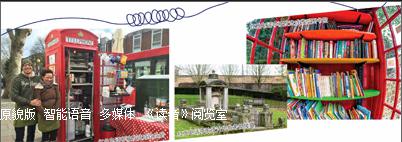红色电话亭:完全的英国范儿
白伊阳

去英国旅游,每一个人都免不了要与伫立在街头的红色电话亭来一张合影,毕竟它是英国最具特色的文化标记之一。在手机普及的今天,红色电话亭已基本失去当初的功用,但它优雅而精巧的设计仍然受人喜爱。而从文化的角度来说,它更像是英国那个已经逝去的时代的象征,同时又是英国自我意识的隐喻。让我们一起跟随本文来了解它的历史由来与文化内涵。
The light emanating1) from a red phone box in the evening was once a symbol of refuge, a beacon2) and a place of connection to the world.
An indispensable part of the UK streetscape, what was once a symbol of a remarkable technology has become a piece of heritage. The last remaining phone boxes survive not because they are needed but rather because they are in conservation areas and are protected, like the buildings around them.
The history of this most British of icons is intriguing, a cocktail3) of influences and cultural markers. The design of the classic kiosk4), the K2, dates from a competition launched in 1924. It was won by the architect Giles Gilbert Scott5), designer of Liverpool Cathedral and Battersea and Bankside power stations—the latter now Tate Modern.
Scott based the phone kiosk design on the unlikely model of Sir John Soane6)s 1815 design for a mausoleum7) for his wife—the original prototype can still be seen beneath the arch of the Royal Academy. So the phone box had the memory of death inscribed8) in its origins. Made of cast iron—manufactured in Scottish foundries9)—the phone kiosk managed to combine historical allusions and the production techniques of heavy industry, a particularly British mix of high tech, engineering and nostalgia.
The red phone box became a cultural symbol, something reproduced as everything from money boxes and biscuit tins to key rings and shower cubicles. It has littered10) popular culture from The Ladykillers11) film to the cover of David Bowie12)s Ziggy Stardust and is so familiar it is one of the indisputable symbols of Britain.
It is now, of course, obsolete13). The ubiquity of the mobile phone has made this curious micro-architecture irrelevant to the lives of almost everyone.
Is its uselessness, perhaps, part of its appeal? The phone box belongs to an era when real attention was paid to making the infrastructure of the everyday beautiful as well as useful.
One of the countrys great architects was commissioned to create a piece of street furniture that was so elegant it became a symbol of the nation itself. It was an attractive and genuinely public structure. The privatised British Telecom did design successor phone boxes but they were ugly and poorly detailed.
Yet is the nostalgia based on a false memory? Anyone old enough to remember feeding endless 2p coins into the slots—if you managed to find a phone that was working— will also remember the fug14) of stale15) cigarette smoke, the stench16) of urine, scratched graffiti, torn up, and damp phone books. With a damp mulch17) of unidentifiable stuff making up the floor and the occasional broken pane18) and cut phone cord, they were often frustrating and unpleasant places to be rather than the nostalgia-pods they now appear.
In a way, the red phone box is a perfect metaphor for Britains sense of self—its crisis of identity. A shelter made for an obsolete technology in the heavy industrial heartlands of Scotland, beautifully designed but inspired by a Regency19) tomb from the year of Waterloo. A design that survives as a symbol of a lost era of care for the civic20) arena by a state-owned utility. It is the most eccentric marker, at once technical and nostalgic, a piece of architecture that belongs in the realm of street furniture and a symbol of a defunct21) typology. Beautiful but useless.
A few of the remaining examples have been turned into anything from art installations and cafés to greenhouses and even micro-libraries. The phone box survives, like so many of the more interesting aspects of the British landscape, as heritage, a part of the national identity the use of which, quite soon, will be obscure and distant.
夜晚,红色电话亭里发出的灯光曾经是庇护所的象征,它是一座灯塔,也是一个与世界连接的地方。
红色电话亭是英国街景中不可或缺的一部分,它曾经象征着了不起的科技成就,如今却已成为文化遗产。现今保留下来的电话亭之所以能够幸存,并不是它们还有用武之地,而是因为它们位于保护区,与周边的建筑一样受到保护。
红色电话亭是最具英国特色的文化标记,它的历史引人入胜,是多种影响因素和文化标记共同作用的结果。这种经典的电话亭又称为K2,其设计可追溯到1924年发起的一场竞赛。在那场竞赛中,建筑师贾尔斯·吉尔伯特·斯科特最终夺魁。斯科特设计了利物浦大教堂、巴特西发电厂和岸边发电厂,其中后者现在已变身为泰特现代美术馆。
斯科特的电话亭设计基于一个出人意料的模型,那就是约翰·索恩爵士在1815年为他妻子设计的陵墓——这座陵墓的原型在皇家艺术学院的拱门下仍能看到。因此,这种电话亭从一开始就被镌刻上死亡的记忆。电话亭使用生铁制成,由苏格兰铸造厂生产,其成功地将历史典故和重工业生产技术融为一体,集英国的高科技、工程技术和怀旧情愫于一身。
红色电话亭成为文化标志,被广泛复制在各种用品上,从存钱罐和饼干盒,到钥匙圈和淋浴隔间,无处不在。它在各种流行文化中随处可见,比如电影《师奶杀手》,又比如大卫·鲍威的专辑《Z字星尘》的封皮。它是如此广为人知,因而成为英国毫无疑问的标志之一。
当然,现在红色电话亭遭到淘汰。手机的普及使这一奇特的微型建筑几乎不再与任何人的生活相关了。
或许无用也是它具有吸引力的部分原因?在红色电话亭所属的那个时代,人们真的下了功夫,把日常生活使用的基础设施打造得既好用又漂亮。
这个国家的一名杰出建筑师接受委托创造出来的这么一件街头物件如此优雅,竟然成了该国的一个标志物。这是富有魅力并且真正属于大众的建筑。私有化后的英国电信公司的确又设计了新一代的电话亭,但它们样子丑陋,一点也不精致。
不过,这样的怀旧情结是不是源自虚假的回忆呢?所有年龄大一点的人都记得,那时即使你设法找到了一部能用的电话,你还需要往电话投币口不停地投放两便士的硬币,也应该记得亭子里污浊的香烟烟雾、尿骚味、乱七八糟的涂鸦和破烂潮湿的电话簿。地板上到处粘着湿乎乎的、无法辨认的东西,窗玻璃偶尔会碎掉,电话线时不时会断掉。那时待在电话亭经常让人觉得沮丧、不快,而不像如今它们倒成了人们怀旧的亭子。
在某种程度上,红色电话亭是英国自我意识的一个绝佳隐喻——象征着英国的身份认同危机。电话亭在苏格兰的重工业腹地制成,是为一项现已过时的技术打造的庇护所;它设计非常漂亮,其设计灵感却源自滑铁卢战役那一年的具有摄政时期风格的陵墓。这一设计作为一种象征保留了下来,象征着已逝去的一个时代,在那个时代里,由国营公用事业公司负责料理民生事务。它是最为怪异的标志,既代表着科技,又象征着怀旧,它属于街头物件的范畴,但也成为过时物品的代表——漂亮却无用。
现存的电话亭有一部分已被改造成艺术设施、咖啡馆、温室,甚至是微型图书馆等。就像英国风景中许多更加有趣的东西一样,电话亭作为文化遗产保留了下来,成了国家身份的一部分,而其用处将会很快变得模糊而悠远。
1. emanate [?em?ne?t] vi. 来自(于),从……散发出
2. beacon [?bi?k?n] n. 灯塔
3. cocktail [?k?k?te?l] n. 混合物
4. kiosk [?ki??sk] n. 公共电话亭,报刊亭
5. Giles Gilbert Scott:贾尔斯·吉尔伯特·斯科特(1880~1960),英国著名建筑师,设计了利物浦大教堂、滑铁卢大桥、巴特西发电厂等英国代表性建筑。
6. Sir John Soane:约翰·索恩爵士(1753~1837),英国建筑师,以新古典主义建筑闻名。
7. mausoleum [?m??s??li??m] n. 陵墓
8. inscribe [?n?skra?b] vt. 刻;雕
9. foundry [?fa?ndri] n. 铸造车间;铸造厂
10. litter [?l?t?(r)] vt. 充满,散布
11. The Ladykillers:《师奶杀手》,指1955年英国上映的黑色喜剧,在2004年被美国导演科恩兄弟重拍。
12. David Bowie:大卫·鲍威(1947~2016),英国著名摇滚音乐家,是20世纪70年代华丽摇滚宗师,其与披头士(The Beatles)、皇后乐队(Queen)并列为英国20世纪最重要的摇滚明星。文中提到的《Z字星尘》(Ziggy Stardust)是大卫于1972年发行的一个专辑,被公认为其最出色的专辑之一。
13. obsolete [??bs?li?t] adj. 过时的,废弃的,淘汰的
14. fug [f?ɡ] n. 室内的闷热空气(或气味);室内烟雾腾腾的空气
15. stale [ste?l] adj. (空气等)污浊的
16. stench [stent?] n. 臭气,恶臭
17. mulch [m?lt?] n. 覆盖层
18. pane [pe?n] n. 窗玻璃,窗格
19. Regency:指1795年至1837年的英国摄政时期,这一时期的建筑、
舞蹈、文化等都有鲜明的特点。
20. civic [?s?v?k] adj. 公民的,市民的;城市的
21. defunct [d??f??kt] adj. 过时的;失效的;已灭绝的

